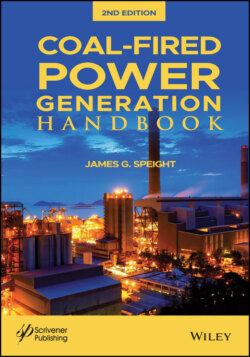Читать книгу Coal-Fired Power Generation Handbook - James Speight G., James G. Speight - Страница 38
2.3.5 International System
ОглавлениеThe International System of coal classification came into being after the Second World War as a result of the greatly increased volume of trade between the various coal-producing and coal-consuming nations. This particular system, which still finds limited use in Europe, defines coal as two major types: hard coal and brown coal. For the purposes of the system, hard coal is defined as a coal with a calorific value greater than 10,260 Btu/lb (5700 kcal/ kg) on a moist, but ash-free basis. Conversely, brown coal is defined as coal with a calorific value less than 10,260 Btu/lb (5,700 kcal/kg). In this system, the hard coals (based on dry, ash-free volatile matter content and moist, ash-free calorific value) are divided into groups according to their caking properties (Chapters 5, 6). These latter properties can be determined either by the free swelling test and the caking property is actually a measure of how a coal behaves when it is heated rapidly (Speight, 2013). The coal groups are then further subdivided into subgroups according to their coking properties (which may actually appear to be a paradox since the coking properties are actually a measure of how coal behaves when it is heated slowly).
Briefly, coking coal is a hard coal with a quality that allows the production of coke suitable to support a blast furnace charge. On the other hand, steam coal is all other hard coal not classified as coking coal. Also included are recovered slurries, middlings, and other low-grade coal products not further classified by type. Coal of this quality is also commonly known as thermal coal.
Table 2.7 National coal board (UK) system of coal classification.
| Class | Volatile matter* (% w/w) | Comments | |
| 101 | < 6.1 | Anthracite | |
| 102 | 3.1 - 9.0 | ||
| 201 | 9.1 - 13.5 | Dry steam coal | Low volatile steam coal |
| 202 | 13.6 - 15.0 | ||
| 203 | 15.1 - 17.0 | Cooking steam coal | |
| 204 | 17.1 - 19.5 | ||
| 206 | 19.1 - 19.5 | Low volatile steam coal | |
| 301 | 19.6 - 32.0 | Prime cooking coal | Medium volatile coal |
| 305 | 19.6 - 32.0 | Mainly heat altered coal | |
| 306 | 19.6 - 32.0 | ||
| 401 | 32.1 - 36.0 | Very strongly coking coal | High volatile coal |
| 402 | > 36.0 | ||
| 501 | 32.1 - 36.0 | Strongly coking coal | |
| 502 | > 36.0 | ||
| 601 | 32.1 - 36.0 | Medium coking coal | |
| 602 | > 36.0 | ||
| 701 | 32.1 | Weakly coking coal | |
| 702 | > 36.0 | ||
| 801 | 32.1 - 36.0 | Very weakly coking coal | |
| 802 | > 36.0 | ||
| 901 | 32.1 - 36.0 | Non-coking coal | |
| 902 | > 36.0 |
*Volatile matter - dry mineral matter free basis. In coal, those products, exclusive of moisture, given off as gas and vapor determined analytically.
A three-digit code number is then employed to express the coal in terms of this classification system. The first figure indicates the class of the coal, the second figure indicates the group into which the coal falls, and the third figure is the subgroup (Table 2.8). For example, by this system a 523 coal would be a class 5 coal with a free swelling index of 2.5 to 4 and an expansion (dilatation) falling in the range 0 to 50.
Table 2.8 Classification of coal by the International System.
